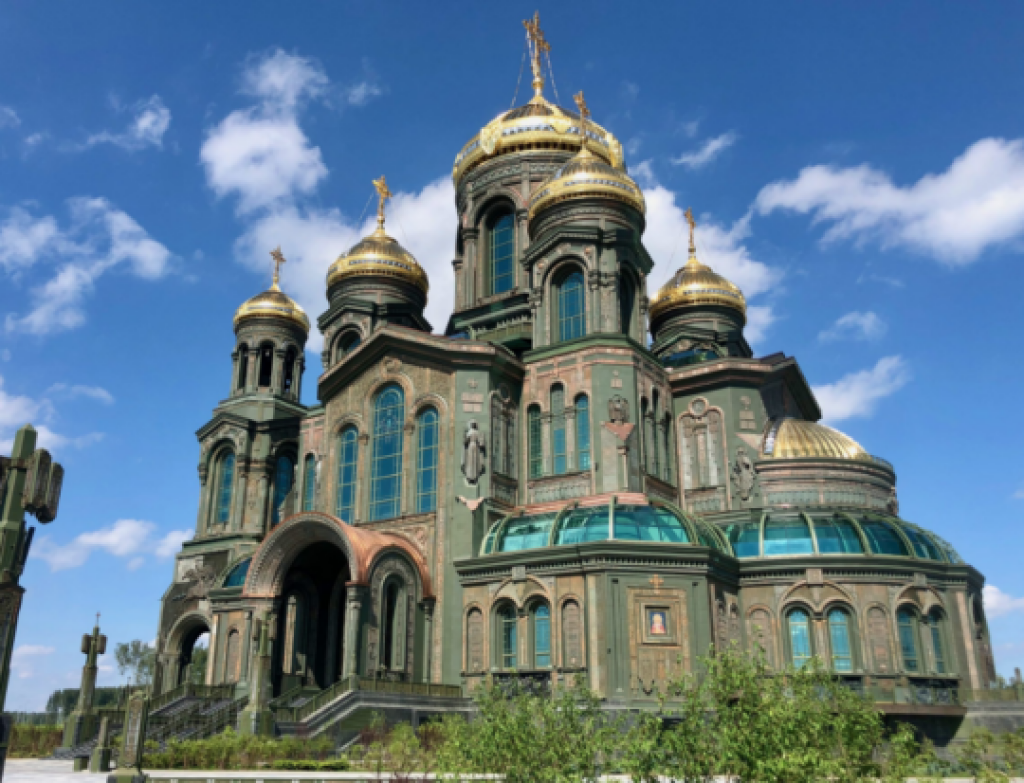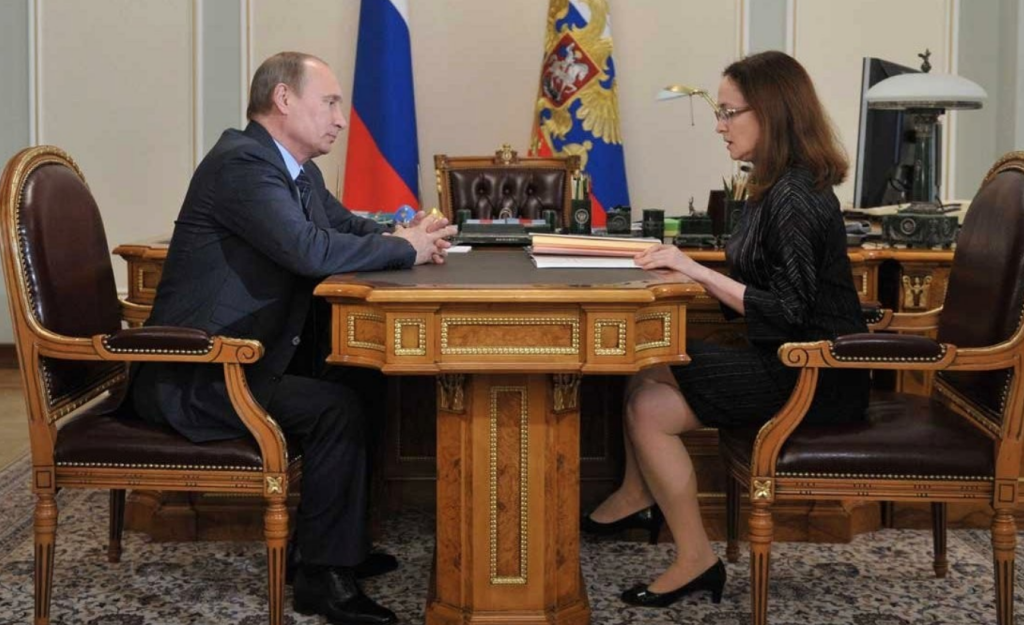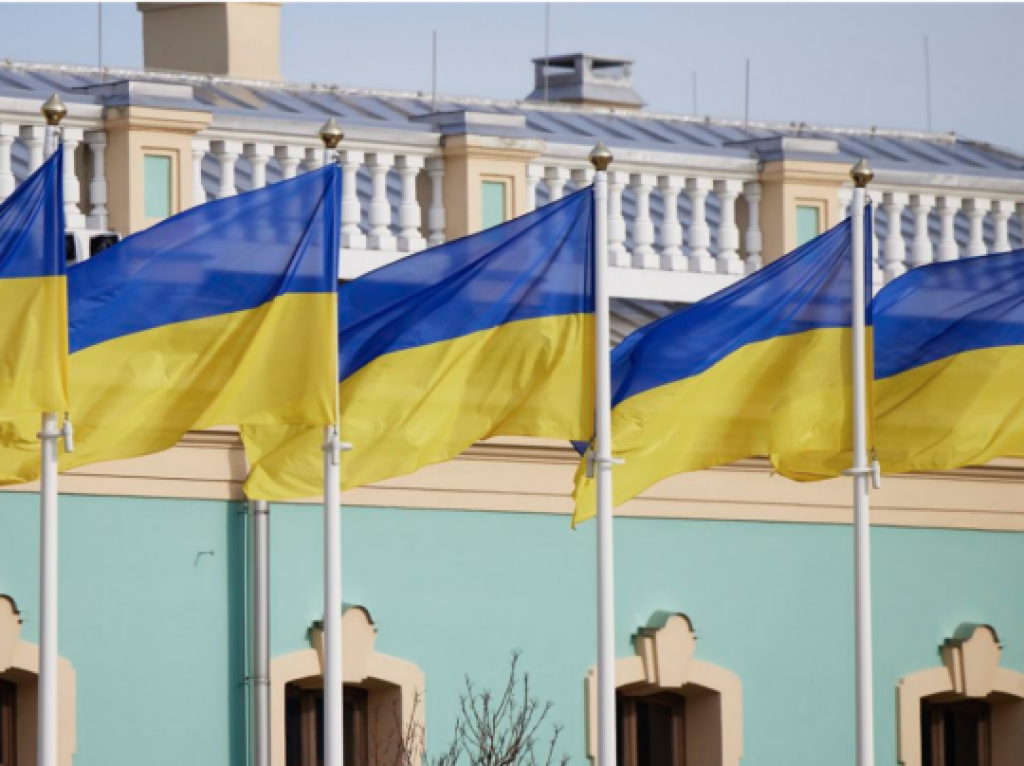Sean Griffin is Associate Professor of Russian at the University of Notre Dame and the author of The Liturgical Past in Byzantium and Early Rus (Cambridge University Press, 2019).
On 14 June 2020, Patriarch Kirill (Gundiaev) consecrated a new Orthodox Christian church: the Main Cathedral of the Armed Forces of the Russian Federation. This sprawling military shrine had recently been built on the outskirts of Moscow, and was dedicated to the memory of the Soviet victory over Nazi Germany in the Second World War. What no one realized at the time, as Kirill blessed the icons and altar, was that the new cathedral not only commemorated previous wars and earlier triumphs. It also pointed ahead to another “holy war” that was still to come: the full-scale Russian invasion of Ukraine in late February 2022.
Critics have described the church’s architecture and iconography as “a comic book of war history” and as “something in between pop-art and Socialist Realism.” So what did these “comic book icons” depict? They showed the armed forces of every historical era—from medieval Rus and the Russian Empire, to the USSR and Putin’s Russia—fighting holy wars against their enemies. And the Russians won these holy wars, the icons told us, because they alone enjoyed the special protection of God, his angels, and, above all, Mary the Mother of God.
In one mosaic, for instance, St. Sergius of Radonezh blessed St. Dmitrii Donskoi before the Battle of Kulikovo against the Tatars in 1380. The Virgin’s greatest efforts, however, were reserved for the Great Patriotic War. Several large mosaics commemorated major, and apparently miraculous, turning points in the war against the Nazis, including the battles of Stalingrad and Berlin. In addition to such battle scenes, the cathedral’s stained-glass windows featured several prominent symbols from the Soviet past. These included the five-pointed red star as well as the Soviet hammer and sickle. To pull it all together, a giant mosaic of Mary—explicitly based on the famous Soviet propaganda poster “The Motherland Calls!”—looked down domineeringly from the western apse. This Holy Soviet Mother of God was the last image that visitors saw as they exited the cathedral.
As these mosaics indicate, the patrons and designers of the Main Cathedral of the Armed Forces wished to make a powerful statement about the historical continuity of their nation. On the walls of the new military shrine, imperial Orthodoxy merged with atheist Communism—the cross merged with the hammer and sickle—in order to tell a story about Russia’s unbroken, one-thousand-year-long history as the holy people (and the holy army) of God. But where, exactly, had this ideology of holy war come from? And what role did these memory politics later play in the Russian invasion of Ukraine?
A sacred sacrifice
The answer to these questions leads us back to the collapse of the Soviet Union. In January 1992, two weeks after the dissolution of the USSR, Metropolitan Kirill of Smolensk—the man who is now Patriarch—delivered an address to nearly 5,000 senior military commanders in the Kremlin.
In his remarks, Kirill was already preaching some of the core myths that would eventually be enshrined in the Main Cathedral. Namely, he stated that fallen soldiers were martyrs for the Fatherland and that their deaths were a sacred sacrifice. Kirill also stressed the unbroken, one-thousand-year long historical continuity of the Russian nation. “Our Fatherland did not form in the past 70 years,” Kirill declared in the same speech. “And it has absolutely nothing in common with the Stalinist empire!”
Clearly, these are not the words and deeds of a hierarch eager to serve the Divine Liturgy beneath a portrait of Stalin or a Soviet Red Star. So how did Kirill go from railing against the “Stalinist empire” in 1992, to personally consecrating a cathedral that glorifies that very same empire in 2020?
The Great Victory
Here is where Vladimir Putin and the May 9 holiday once again enter the picture. In the year 2000, Victory Day fell only 48 hours after Putin’s inauguration, and the celebration was by far the largest since the collapse of the Soviet Union. As the years passed, May 9 celebrations gradually assumed greater and greater importance. Propaganda related to the Victory began to appear in Russian cities for weeks and months before the date itself. For the 70th anniversary celebrations in 2015, for example, giant billboards all over Moscow advertised “Our Victory,” while hammer and sickle flags lined the city’s streets.
These developments were not lost on Patriarch Kirill and his inner circle. In 2009, Kirill suddenly began to discern a much deeper spiritual meaning to the events of the Second World War. “Why was the [Great Patriotic War] so terrible and bloody?” the patriarch asked in a sermon. “This was a punishment for sin, for the terrible sin of national apostasy… But the Lord washed away this untruth, evil, and human suffering with the blood of our fathers. We must therefore discern with a special, religious understanding the redemptive meaning of the Great War of the Fatherland.” This final phrase is crucial, since it points to the redemptivemeaning of the Great War in contemporary Russia. The Patriarch linked the redemptive, saving sacrifice of Christ on the Cross—the sacrifice that washes away the sin of the world—with the Soviet sacrifices of the Second World War.
Kirill claimed that the 27 million Soviets who died during the war were part of a much greater providential plan. They were sacrificed, he argued, on the “altar of Victory”—a phrase that Kirill used frequently—so that the sins of the October Revolution and Stalinism could be forgiven, and the Russian people could return to the Orthodox faith. Thus, in Kirill’s “theology of victory,” the Great Patriotic War was interpreted as a collective, national crucifixion: a sort of Soviet Golgotha.
The Second Great Patriotic War
It was precisely this sacred politics of memory and cult of the Great Victory that Russian leaders drew on repeatedly when speaking about the invasion of Ukraine. In his speeches in late February 2022, for example, Putin made nearly a dozen references to Nazis and neo-Nazis, while also calling to mind the “holy sacrifices” made by the Soviet people “on the altar of victory” in the Second World War.
Predictably, many patriotic Russian Orthodox clergymen rushed to embrace the Kremlin’s “sacred war” narrative. “Today, on the lands of Holy Rus, […] an armed conflict is taking place between the Russian people and the collective Hitler and enemies of Holy Orthodoxy!” Archpriest Igor Pashmenov told his flock seven days after the start of the invasion. In a similar vein, Archpriest Aleksii Kasatikov invoked a song from a Soviet war film to describe the campaign. “If necessary, we can do it again!” he proclaimed, alluding to the Second World War. “Our country ended the war in 1945, and we will end it again today!” In this instance, the churchman drew on a popular propaganda slogan, mozhem povtorit’, which has circulated widely in Russia for at least a decade.
These examples were not fringe views. In the politics of memory preached by politicians and priests alike, Russian soldiers were fighting for the existential survival of the Motherland, in the same fashion that their Soviet forbears fought against Hitler’s invasion. This time around, however, Kyiv was the new Berlin; Zelensky’s administration and NATO were the new Nazis; and the entire country was waging a “holy war” against “godless aggressors” from the West. It was nothing less than a second “Great Patriotic War.”
Conclusion: A sacrifice unto idols
The great temple of Mars, the great shrine of this new holy war was the Main Cathedral of the Armed Forces. Long before the outbreak of the war, Russia’s most famous clerical dissident, the defrocked deacon Andrei Kuraev, had issued a warning about the church’s true nature. “I fear that this church is not the subject of a religious Orthodox cult,” he said in a televised interview. “It is a cult object of a new religion: the civil religion of Russia, the religion of victory. Thus, it turns out that our altar is not dedicated to Christ—and not to his victory—but rather it is dedicated to something completely different.” At the time, Kuraev refrained from elaborating on what this “something different” might be and left it as an open question.
In late February 2022, the answer to that question became chillingly clear. Putin’s “altar of victory” was not dedicated to Christ, as many critics had long known, but rather to the idols of sacred Russian empire and holy war. Thus, seemingly overnight, the cult of the Great Victory was transformed into the war cult of the Russian invasion. And the “holy war” against the Nazis in the Second World War was transformed into the pretext for a new “holy war” against alleged “Nazis” in Ukraine.
Idols are not self-sufficient constructions, however. They are never built for their own sake, but designed to curry divine favor through sacrifice. After over two years of bitter fighting in Ukraine, there can no longer be any mistake about what Putin has chosen to sacrifice upon his “altar of victory”: the blood of hundreds of thousands of Ukrainian men, women, and children, and perhaps an even greater number of Russian soldiers.
While such sacrifices have no place in traditional Christianity, they are surely pleasing to the idols of the “Great Victory” and the Main Cathedral of the Armed Forces. For this is the story that the mosaics inside the cathedral ultimately tell: that no matter what historical path Russia takes, and no matter what regime is in power—whether its leaders are building churches or gulags, baptizing Kyivans or bombing them, God is always on their side. Mary, or Rodina-mat’, the Goddess of War, never abandons them.



